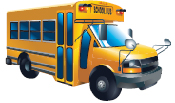Commercial Vehicle Safety and Enforcement
Frequently Asked Questions
When do I need to fill out a trip inspection report?
A driver must complete a trip inspection report before driving the commercial motor vehicle for the first time in a day.
This does not apply to:
(a) a commercial motor vehicle rented for a single trip
(b) an emergency vehicle
(c) a two axle commercial motor vehicle with a licensed gross vehicle weight not exceeding 14,600 kg, excluding a bus, school bus, special activity bus or special vehicle
(d) a taxi where the driver is required to notify the carrier immediately of any defects found during inspections
How do I dispute a Violation Ticket?
Do I have to report to scales if I’m bobtailing? Why?
All commercial vehicles with a licensed GVW exceeding 5,500 kg are required to report to scales, including those being used for bobtailing. Vehicles are checked at the scales for important safety items. These items remain important regardless of whether the vehicle is being used temporarily for personal use.
A police officer or peace officer gave me a Notice and Order; where can I take my vehicle for an inspection?
A Notice and Order issued against a vehicle by a police officer or a peace officer requires that the vehicle be repaired and presented to a Designated Inspection Facility for inspection. Locations of all Designated Inspection Facilities can be accessed at an ICBC Driver Services Centre, Autoplan Agent or on the Commercial Vehicle Safety and Enforcement Branch (CVSE) website under “What’s New.” Alternatively, you may call any Commercial Vehicle Safety and Enforcement Branch office for the information. The CVSE website also contains a listing of the CVSE Branch contact numbers. The website address is www.CVSE.ca
What is a box 2 Notice and Order?
A Notice and Order is an enforcement tool requiring certain actions to be taken. Police officers and peace officers may issue a Notice and Order. A Box 2 Notice and Order requires a vehicle to be repaired and presented promptly to a Designated Inspection Facility for an inspection. An Authorized Inspector at a Designated Inspection Facility will conduct the vehicle inspection and complete an inspection report. A passed inspection report must be provided to the Commercial Vehicle Safety and Enforcement Branch within 30 days.
The consequence of not complying with the order is that the vehicle will not be allowed to operate on a highway, nor will the vehicle be permitted to renew the vehicle licence and insurance. It is also an offence to operate a vehicle if the Notice and Order has not been complied with.
Are there any laws to prohibit noisy vehicles, especially noisy motorcycles?
Yes, Division 7A.01 of the Motor Vehicle Act Regulations prohibits loud and unnecessary noise from the engine, exhaust system or the braking system of a vehicle, or from the contact of the tires with the roadway. The regulations do not discriminate between motorcycles and other types of vehicles.
How much weight is allowed on a tri-axle trailer behind a Tri-drive? And behind a tandem?
Tri-axle trailers which are towed behind either a Tridem or tandem drive truck are legally allowed 24,000 kg when transporting any type of load, except long logs (see appendix “F” table vi of the Commercial Transport Regulations). When a tri-axle trailer is towed behind either a tridem or tandem drive truck hauling long logs they are legally allowed 26,100 kg on the trailer (refer to appendix “I” of the Commercial Transport Regulations).
For a log trailer, what type of standard should be used to secure the trailer that’s loaded up?
Logging trailers (i.e. pole, tri-axle and quad) which are transported empty on logging trucks are only required to use one tiedown which meets fifty percent of the weight of the trailer.
How does one calculate how much weight is allowed during road restrictions?
If the road is restricted to 100 percent of legal axle loading, you are allowed to operate at legal weights as per the Commercial Transport Regulations. However, if the road is restricted to 70 percent of legal axle loading, then the legal axle weight allowed would be 70 percent of legal, for example: tandem axle is allowed 17,000 kg legal with the 70 percent reduction it would be allowed 11,900 kg.
How much weight is allowed on the steering of a tri-drive?
Tridem drive trucks and/or truck-tractors are allowed 7,300 kg on the steer axle without permanently mounted equipment and 9,100 kg with permanently mounted equipment. This information can be found in the steer axle weights section of appendix “B” of the Commercial Transport Regulations.
What are the legal dimensions with logs?
The legal length for a logging truck two-vehicle combination with one articulating point is 21.5 metres. Logging tuck combinations with more than one articulating point are allowed 23 metres overall length.
Is the weight allowance for logs lost or affected when seasonal road restrictions come on? What is the allowance?
Logging weight allowances in Division 7.26 of the Commercial Transport Regulations are not reduced when the road is restricted to 100 percent of legal axle loading. However, when roads are restricted to less than 100 percent (70 percent for example), then the carrier only gets 70 percent of the weight allowance.
What’s legal and max for size and weight? (pertaining to everything)
There are many legal weights and dimensions for vehicles and vehicle combinations; please refer to the Commercial Transport Regulations appendices “A” to “I.”
How big can my pick-up camper or RV trailer be on my ½, ¾, or 1 tonne pickup be? Do I need brakes? Do I need a special driver’s license?
The camper, when loaded on to the pickup or when you tow a trailer behind the pickup, can not exceed the manufacturer “Gross Vehicle Weight Rating” (GVWR) or the “Gross Axle Weight Rating” (GAWR). The ratings can be found on the driver’s side door post.
What can my overall length be with a Bed Truck?
The maximum legal overall length in British Columbia for bed trucks is 12.50 metres which can be found in appendix “B” of the Commercial Transport Regulations.
What can my overall length be with a Picker (Pick-up?) Truck?
The maximum legal overall length of a picker truck-tractor is 12.50 metres as per appendix “B” of the Commercial Transport Regulations. However, under permit the maximum overall length including the front mounted crane is 16 metres as per Bulletin 41, paragraph 7 of the Commercial Transport Procedures manual.
How do I determine Bridge Formula?
Bridge formula is 30 times the wheelbase* in centimetres plus 18,000 kg.
*Wheelbase in the above Bridge Formula calculation refers to the maximum axles span (center of the first axle to the center of the last axle of any axle group) in a heavy commercial vehicle.
How do I measure my inter-axle spacing and why is this required for overweight permits?
Inter-axle spacing is measured from the centre of the last axle (i.e. tandem axle) to the centre of the first axle in the adjacent group of axles (i.e. tandem axle). The inter-axle spacing is required to determine legal allowable weight and for calculating bridge formula for the group of axles.
I want to import a used vehicle from outside of Canada. What will I need to do in order to get it licensed and insured in BC?
First check the attached Transport Canada website and verify if the vehicle is admissible into Canada
Second check the attached ICBC Website
Third, the vehicle must pass a Motor Vehicle Inspection at a Designated Inspection Facility. You can get a list of inspection facilities on our website
What class driver’s licence do I need with certain vehicles?
BC has 8 driver licence classes:
 Class 1
Class 1
Any tractor trailer combination and all other classes of motor vehicles except motorcycles.
 Class 2
Class 2
Buses and vehicles in Classes 4 and 5. Trailers may not exceed 4,600 kg except if the bus and trailers do not have air brakes.
 Class 3
Class 3
Trucks with more than two axles, including dump trucks and large tow trucks, and vehicles in Class 5. Trailers may not exceed 4,600 kg except if the truck and trailers do not have air brakes.
 Class 4
Class 4
Taxis, limousines, ambulances, buses up to 25 passengers including the driver, special buses used to transport people with disabilities, and vehicles in Class 5.
 Class 5 or 7
Class 5 or 7
Two-axle passenger cars and light trucks, motor homes (including those with more than two axles), limited speed motorcycles (e.g., mopeds and mini scooters), all-terrain vehicles, construction vehicles, buses and vans seating not more than 10 people. Allows towing of trailers up to 4,600 kg.
 Class 6 or 8
Class 6 or 8
Motorcycles, all-terrain cycles, all-terrain vehicles.
Drivers in BC’s Graduated Licensing Program are issued Class 7 and/or 8 driver’s licences. For more information check the ICBC website at www.icbc.com/licensing or contact your local driver licensing office.
When towing a trailer is it necessary to get more than a class 5 driver’s licence to tow his trailer?
A Class 5 or 7 passenger car driver’s licence allows towing trailers up to 4,600 kg. To tow a trailer that weighs more than 4,600 kg, you need:
(a) A Class 1,2, or 3 driver’s licence, or
(b) A Class 4 or 5 driver’s licence with a heavy trailer endorsement (code 20), or
(c) A Class 4 or 5 driver’s licence with a house trailer endorsement (code 51)
For more information check the ICBC website at www.icbc/licensing or contact your local driver licensing office.


